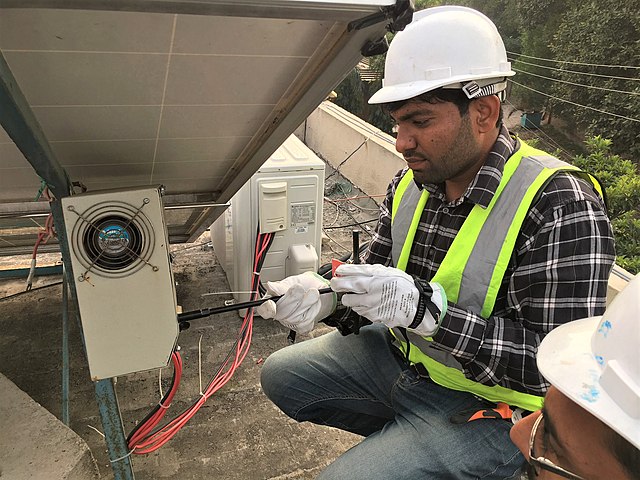US Solar Collaboration to Power the Developing World
 As the greater community of nations constantly collaborates for sustainable, alternative energy solutions, one key issue that has been at the forefront of these discussions has been developing nations’ inability to take advantage of the road toward alternative energy. Due to the experimental and expensive nature of alternative energy and the need for more infrastructure, the world leaves developing nations behind in its collective pursuit of new methods of harnessing energy to power the increasingly industrialized planet. The United States (U.S.), particularly U.S. solar companies, can mitigate the absence of resources by expanding its solar power grid and forming a symbiotic relationship with the developing world. U.S. solar collaboration can be an innovative form of global poverty relief that grows the U.S. solar industry and its profits, expands developing nations’ economies and provides the globe with new energy sources.
As the greater community of nations constantly collaborates for sustainable, alternative energy solutions, one key issue that has been at the forefront of these discussions has been developing nations’ inability to take advantage of the road toward alternative energy. Due to the experimental and expensive nature of alternative energy and the need for more infrastructure, the world leaves developing nations behind in its collective pursuit of new methods of harnessing energy to power the increasingly industrialized planet. The United States (U.S.), particularly U.S. solar companies, can mitigate the absence of resources by expanding its solar power grid and forming a symbiotic relationship with the developing world. U.S. solar collaboration can be an innovative form of global poverty relief that grows the U.S. solar industry and its profits, expands developing nations’ economies and provides the globe with new energy sources.
This crucial shift could transform many nations where access to electricity is greatly underdeveloped. Nations like Cambodia where 75% of the population lives in rural areas could have their livelihoods transformed through American solar collaborative efforts.
Global Solar Expansion and US Opportunity
Developing countries present immense opportunities for U.S. solar collaboration. Since CarbonBrief indicates that developing countries have new driving potential in solar energy output, communities are more open to seeking affordable and sustainable energy sources. As leaders in innovation and technology, U.S. solar companies are in the most strategic position to contribute to this global paradigm shift. Solar Energy International, an organization numerous U.S.-based solar companies attend, is an example of one of the newest trends by U.S. companies, taking advantage of the increasing affordability of solar technology and the growing demand for alternative energy sources. Consequently, U.S. companies have acquired new opportunities to engage with the developing world in this project.
Examples of Successful Collaboration
USAID lists a notable instance of U.S. solar collaboration leading development efforts as partners within the private sector that the agency works with to power Africa. Several U.S. companies have partnered with USAID to support energy growth in Africa, “committing toward more than $40 billion in investments into African energy markets,” including energy grids within sub-Saharan Africa.
Additionally, 60Hertz Energy is a U.S.-based startup that implemented computerized maintenance management software systems to streamline operations and maintenance for solar infrastructure that can withstand extreme environments. As it works to establish itself in sub-Saharan Africa, it has developed a presence in Benin, Nigeria, Sierra Leone and Uganda, according to USAID. The work that 60Hertz Energy commits itself to would improve the quality of life for residents and could position the U.S. solar industry as a key player within the emerging alternative fuel paradigm.
In another instance, Acumen, a U.S.-based nonprofit impact investment fund, has invested $88 million into 82 different companies that provide “agricultural inputs, quality education, clean energy, health care services, formal housing, safe drinking water and sanitation services to low-income” recipients in East Africa, West Africa and Latin America, according to USAID. This strategic effort by the U.S.-based fund to finance various companies could make a direct impact by providing a multifaceted approach that can harness results favorable to the African solar power industry and showcase the benefits of cooperation by multiple firms.
Economic Growth and Sustainable Development
Beyond the numerous advantages for U.S. companies, solar infrastructure that originates from the U.S. to assist developing nations can potentially contribute to economic growth and sustainability in other ways. As part of the World Bank’s commitment, recipient nations that achieve affordable, reliable and modern energy services, including alternative energy sources to achieve that objective, could provide a catalyst that improves the living and working conditions for all of humanity. The most vulnerable demographics, particularly those most affected in developing countries without access to modern energy sources, will be most served by transitioning to a net-zero-emissions energy system. Therefore, a sustainable energy grid substantiated by U.S. solar could provide these benefits. In doing so, sustainable communities could create stability across the continent to empower communities and foster entrepreneurship. The U.S. would have a crucial role in building upon its geopolitical status if it were to commit itself to these arrangements.
By embracing the symbiotic framework between the U.S. and its private sector with the opportunities offered by the developing world, U.S. solar could become the forefront of sustainable growth, leading to the global prosperity many of the world’s poor need.
– Arman Ahmed
Photo: Wikimedia
